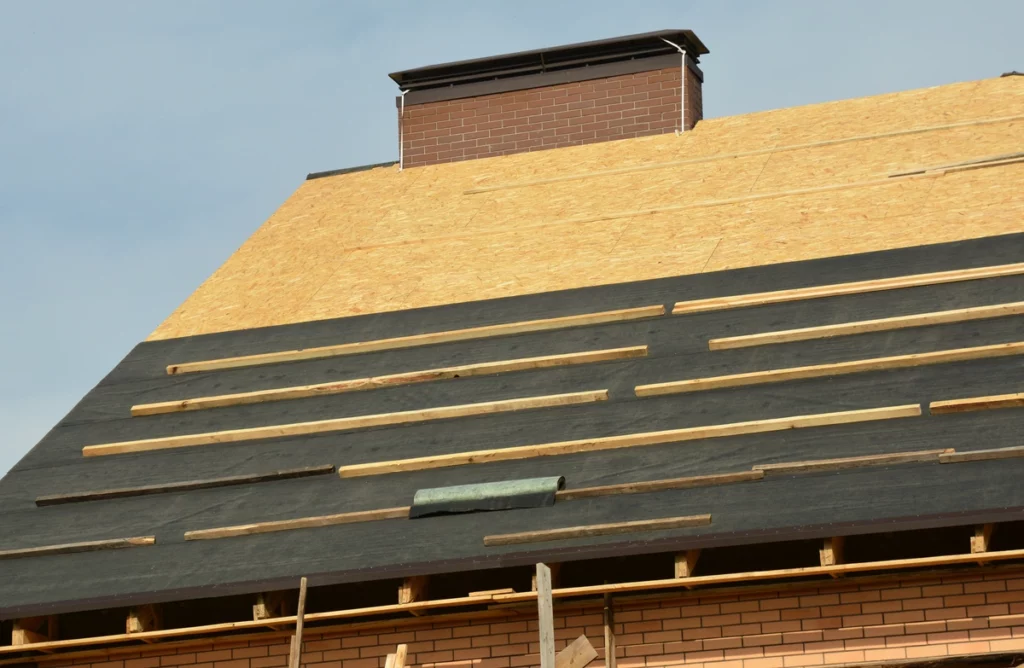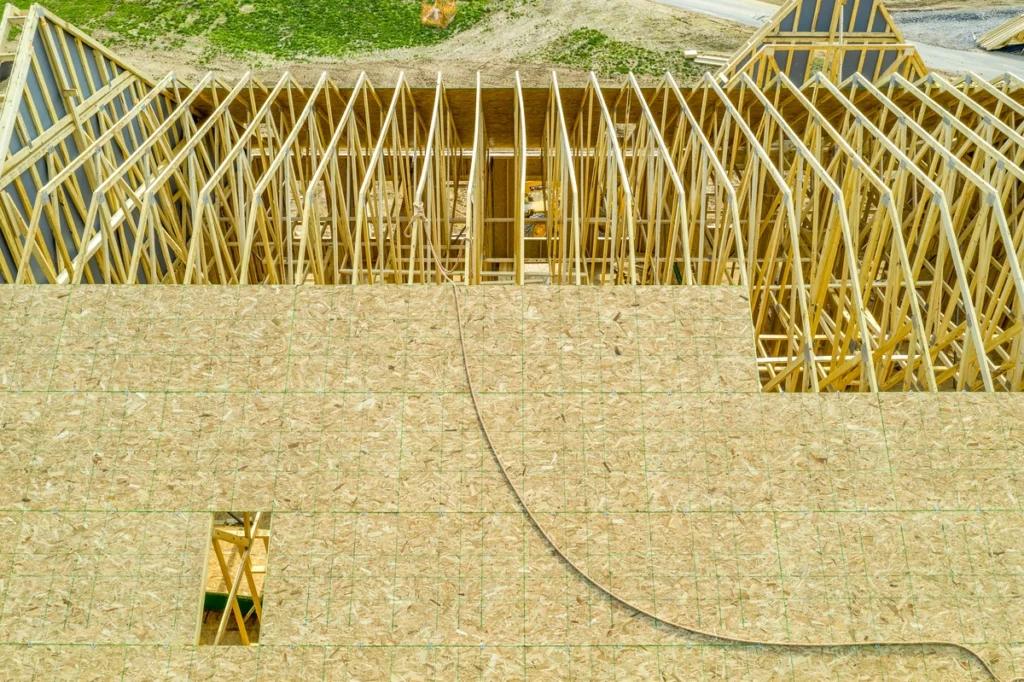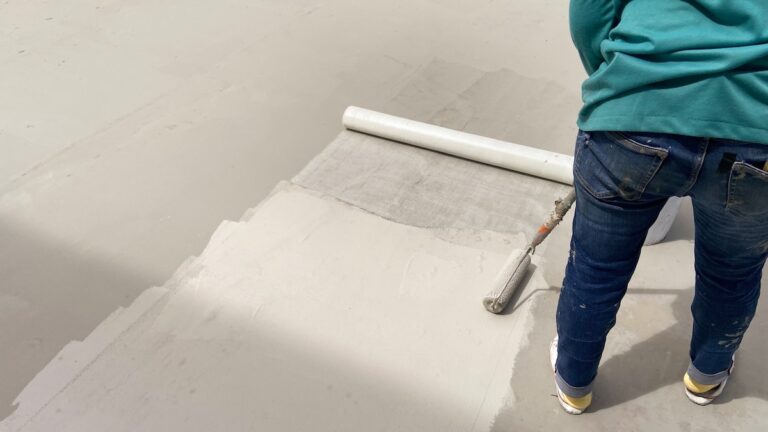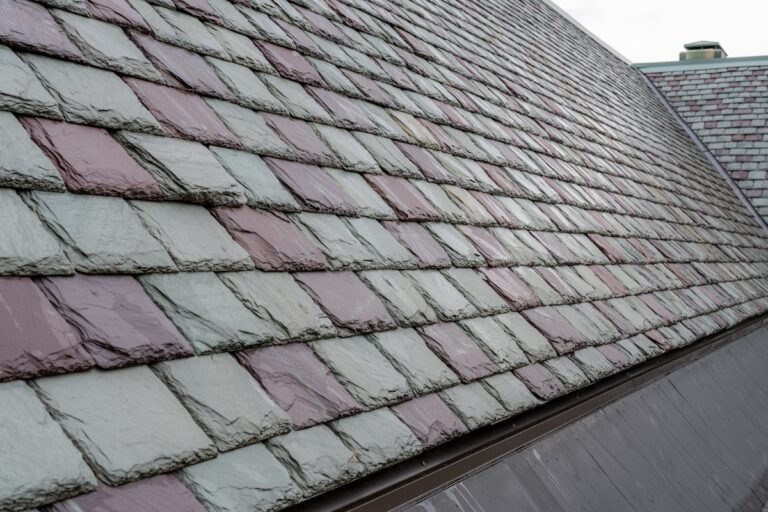At first glance, a roof’s rooftop decking component looks more like a piece of plywood than anything else. But underneath that copper, tin, zinc, or stainless steel exterior lies a highly functional part of your home’s exterior. This underlying layer, often referred to as sheathing, is what truly anchors your entire roofing system, acting as the bridge between your home’s framing and its outermost defense against the elements.
Roof decking provides several critical benefits to your structure, including, but not limited to:
- Sound absorption
- Aesthetically pleasing design
- Waterproofing
Read on to learn everything you need to know about roof decking, from the materials it’s made of to the crucial role it plays in structural integrity. By understanding the function of roof decking, you can recognize the warning signs that indicate it may be time for a crucial replacement, protecting your home for decades to come.
Key Takeaways
- Structural Foundation: Roof decking (or sheathing) is the foundational layer that supports all roofing materials and adds essential structural rigidity to the system.
- Common Materials: The primary materials used for roof decking are plywood (for strength) and Oriented Strand Board (OSB) (for cost-effectiveness).
- Warning Signs: Watch for clear damage indicators like sagging rooflines, soft/rotted spots, water stains on ceilings, and light visible from the attic.
- Consequences of Failure: A damaged deck causes leaks, mold growth, poor ventilation, and can lead to structural collapse.
- Replacement Cost: The average cost for replacing damaged roof decking is between $1,000 and $3,000 (material only), which prevents far more expensive structural failure.
Roof Decking Explained

Roof decking, or roof sheathing, is your roof’s foundation. It is the layer of flat panels installed over the structural trusses or rafters and provides a solid base for the roof covering. Roof decking is typically made of wood, plywood, or oriented strand board (OSB). Its primary function is to support the weight of the roofing materials, distribute the load evenly across the roof structure, and provide a stable surface for the underlayment and shingles.
The roofing material you choose, such as asphalt shingles or metal roofing, sits atop the roof decking. It is essential to have a solid and durable roof deck to ensure the proper installation and performance of the roofing materials. Without a solid foundation, your roof may become vulnerable to damage from wind, rain, and other weather elements.
During installation, the roof decking is nailed or screwed into the trusses, creating a secure attachment. The seams between the panels are staggered to provide additional strength and prevent water intrusion. The panels’ length and width depend on the roof’s size and shape and are cut to fit accordingly.
The Importance of a Strong Roof Deck:
A sturdy roof decking foundation is essential for your roof’s overall integrity and longevity. It acts as a structural element, transferring the load from the top to the walls and foundation of the house. A weak or damaged roof deck can lead to several issues, including sagging, leaks, and roof collapse. Additionally, a compromised roof deck can negatively impact the performance of your insulation and ventilation, leading to higher energy costs and a less comfortable living environment.
When the roof deck is weak or deteriorating, it cannot effectively support the weight of the roofing materials. This can cause the roof to sag or develop dips and valleys, compromising the overall structural integrity. Hanging or uneven areas on the top are clear signs that the roof deck needs attention.
A damaged roof decking can also lead to water infiltration and leaks. If the roof deck is compromised, water can enter your home, leading to structural damage, mold growth, and other issues. Your attic may become moist, creating an ideal mold and mildew development environment. Moreover, water leaks can damage your ceiling, walls, and insulation, resulting in costly repairs.
Furthermore, a weak roof deck can interfere with proper insulation and ventilation. Insulation helps regulate the temperature in your home, keeping it cool in the summer and warm in the winter. However, if the roof deck doesn’t provide a sturdy base, insulation may not be as effective, leading to inconsistent temperatures and increased energy costs. Ventilation is also essential for expelling excess heat and moisture from your home and maintaining a comfortable environment. A compromised roof deck can hinder proper ventilation and trapping heat and water, leading to various problems, including mold growth, wood rot, and high humidity levels.

Roof Decking Materials: Plywood vs. OSB
Understanding the composition of your roof decking is essential, as the material choice directly impacts your roof’s durability, cost, and moisture resistance. Today, homeowners primarily choose between two robust wood-based options, though metal and plank decking are used in specialized applications. Knowing the pros and cons of each type of roof decking helps you make the most informed decision before any replacement begins.
Oriented Strand Board (OSB) Decking
OSB has become the most common material used for roof decking in modern construction. It is engineered by compressing and gluing together layers of wood strands, making it highly uniform and cost-effective.
- Pros: Generally the more affordable option; offers excellent structural uniformity and strength over long spans.
- Cons: More susceptible to swelling or deterioration if exposed to moisture for prolonged periods compared to plywood.
Plywood Decking
Plywood is a traditional roof decking material made from thin wood veneers glued together in alternating directions. It offers exceptional strength and has been a proven standard in the roofing industry for decades.
- Pros: Excellent structural strength and a high strength-to-weight ratio; resistant to moisture damage and delamination when properly treated.
- Cons: Typically more expensive than OSB; older or untreated plywood is prone to swelling if leaks are not addressed promptly.
Ultimately, the correct material for your roof decking depends on your local climate, budget, and the structural requirements of your home.
Signs It’s Time for Roof Deck Replacement:
Over time, the roof deck can deteriorate due to various factors such as age, moisture intrusion, and pests. Homeowners must be aware of the signs indicating that it’s time for a roof deck replacement:
- Sagging or Uneven Roof: If you notice dips or uneven areas on your roof, it could indicate underlying problems with the roof deck. Flagging indicates a weakened roof deck; immediate action is necessary to prevent further damage.
- Water Stains or Leaks: Water stains on your ceiling or walls or recurrent leaks during rainstorms can be signs of a damaged roof deck or ineffective underlayment. These issues should not be ignored, as they can lead to more extensive water damage and mold growth.
- Rotted or Soft Spots: Check for rotted or soft roof deck areas during routine inspections. Moisture, pests, or inadequate ventilation can cause these weakened spots. Touching or walking on these areas could result in further damage.
- Visible Light from Attic: Seeing sunlight through gaps or cracks in your attic is a clear sign that your roof deck needs attention. Sunlight should not be able to penetrate through the roof, indicating potential weaknesses in the deck’s structure.
Professional inspections and maintenance can help identify these signs and allow you to prevent roof decking from damage. By taking action when necessary, you can preserve the integrity of your roof and protect your home from potential damage.
The Cost of Roof Deck

The cost of replacing a roof decking section can vary widely, but it is a necessary investment to protect your home’s structure. The average cost for replacing just the roof decking often falls between $1,000 and $3,000, but this figure does not include the price of new shingles, underlayment, or labor for the entire roofing system. The final price hinges on the scope of the project:
- New Roof Installation (Preventative Cost): If only small, damaged sections are replaced during a full re-roof, this adds a small, preventative cost to the project, ensuring the new materials have a solid foundation.
- Targeted Repair (Localized Cost): Repairing decking for a single leak is confined to a small area and is the least expensive option.
- Full Deck Replacement (Structural Cost): This is the most costly scenario, occurring when the entire deck has rot or water damage, requiring substantial labor and material costs.
Factors such as the size of your roof, the material used (OSB vs. Plywood), and the complexity of the job all influence the final bill. Investing in the proper roof decking is vital, as it’s far cheaper than repairing structural damage caused by leaks.
Take Action to Protect Your Home
Now that you understand the importance of a strong and stable roof deck, it’s crucial to take action to protect your home. Regular DIY and professional roof inspections can help identify any signs of damage or deterioration. Suppose you notice any of the warning signs mentioned earlier. In that case, it’s essential to consult a roofing professional to assess the condition of your roof deck and recommend the necessary repairs or replacement.
By being proactive and addressing roof deck issues promptly, you can save yourself from costly repairs down the line and ensure the safety and longevity of your roof. Contact Johnson Restoration today and learn more about roof decking.






